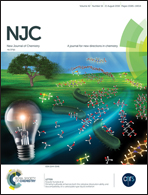Preparation and energy storage application of a long-life and high rate performance pseudocapacitive COF material linked with –NH– bonds†
Abstract
A new covalent organic framework material (NWNU-COF-1) linked with –NH– bonds is synthesized by the condensation reaction of melamine and 2,4,6-trichloro-1,3,5-triazine and its structure and properties are characterized by Fourier transform infrared (FT-IR) spectroscopy, powder X-ray diffraction (XRD), thermogravimetric analysis (TGA), N2 adsorption–desorption, X-ray photoelectron spectroscopy (XPS) and scanning electron microscopy (SEM). The BET specific surface area of NWNU-COF-1 is 301.149 m2 g−1, and the pore size is about 1.41 nm. The preparation is also simple and cheap. This material exhibits a significant pseudocapacitance characteristic in a 6 M potassium hydroxide electrolyte, and the highest specific capacitance value of 155.38 F g−1 at 0.25 A g−1 current density in a three electrode configuration. This COF also demonstrates about 100% capacitance retention after 20 000 galvanostatic charge–discharge cycles, which is equal, even better compared with the COF materials reported previously, the nano/mesoporous carbon materials and even nitrogen doped carbons.



 Please wait while we load your content...
Please wait while we load your content...